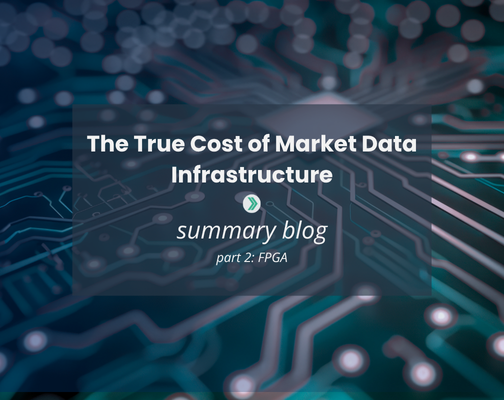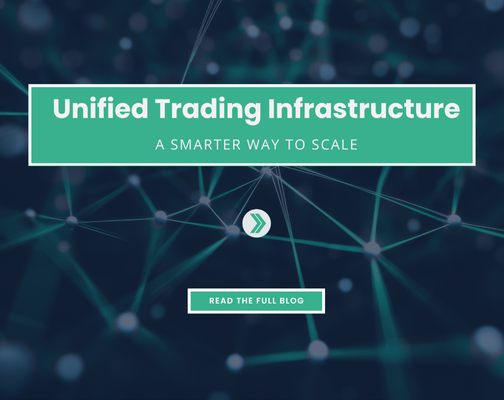Break the Bottleneck: Scale Market Data Infrastructure Without the Sprawl
A Smarter Path for Brokers Facing Power, Space, and Performance Pressure
Co-location space is limited. Power costs are climbing. Yet, market data volumes show no signs of slowing. For many firms, the only response has been to add more: more cores, more servers, more complexity. But, in today’s environment, more isn’t scalable. Especially when infrastructure costs are outpacing performance gains.
Legacy architectures weren’t built for today’s volumes. Systems originally designed to process feeds as quickly as possible are now passing that burden downstream – flooding smart order routers (SORs) and trading applications with untailored data they can’t efficiently manage. What started as a market data problem has become a trading infrastructure problem.
Exegy Nexus was created to solve it — with centralized, hardware-accelerated processing that delivers only the data each application needs, right when it needs it.
While Nexus was originally built for the most demanding trading environments, it addresses three critical challenges across the market:
- Reducing the data center footprint
- Minimizing end-to-end latency
- Unifying fragmented trading infrastructures
In this blog, we focus on the first: helping agency brokers shrink their infrastructure footprint without sacrificing control, performance, or future scalability.
The Cost of Falling Behind
When infrastructure lags market demands, the financial repercussions are immediate and compounding. Firms are experiencing increased slippage as they struggle to react quickly to market-moving events missing optimal prices and falling behind competitors who remain fully active
Outages and latency spikes, once rare, are now routine. When a server loses sync with the exchange, firms typically pause trading until full visibility is restored, especially in agency settings where best execution must be proven. During that window, they’re effectively out of the market. While competitors continue quoting and trading, delayed participation can lead to slippage and missed opportunities. Over time, consistent underperformance can lower a broker’s rankings in client algo wheels leading to reduced order flow and tighter margins.
For agency brokers, this isn’t just a trading issue — it’s a business risk. Poor execution performance results in lower rankings in client algo wheels, which in turn leads to reduced order flow from institutional clients. That decline worsens exchange tiering, increases execution fees, and erodes profit margins. Over time, the cycle reinforces itself turning infrastructure limitations into compounding competitive disadvantages.
The performance-to-flow feedback loop either accelerates growth or compounds losses:
- High-quality execution boosts rankings, earns more flow, and improves your exchange tier, lowering costs and boosting profitability.
- Low execution caused by latency spikes, outages, or stale data degrades rankings, disrupts client flow, and increases costs. Ultimately, it damages both revenue and reputation.
In today’s markets, every microsecond matters. Flooding SORs with untailored data adds latency at the most critical point in the trade lifecycle, stalling execution and weakening performance. Minor delays in market data processing not only cause missed opportunities but also lead to lost client trust, unfavorable economics, and a shrinking competitive edge.
In response, many firms throw servers at the problem. However, this strategy is expensive, space-constrained, and ultimately unsustainable.
The Limits of Legacy Options
As market data volumes surge and firms face performance issues, they lean on two familiar strategies:
- Scaling horizontally with more computing resources
- Moving to Centralized Processing to reduce infrastructure strain
Once effective, these solutions are now hitting hard limits in terms of computing, space, and cost. Most critically, none of these choices provide a long-term solution to deal with today’s volatility and the rising volume of market data.
Existing Approaches Aren’t Enough
Scaling horizontally: Many firms once adopted embedded feed handlers as a cost-effective way to compete on latency without investing in FPGA-based solutions. It worked until data volumes eclipsed computing resources. Today, those setups consume too much compute and inflate infrastructure footprints.
To keep pace, firms added more servers, more racks, and more complexity. But with limited co-lo space and rising power costs, horizontal scaling has become unsustainable turning what was once a performance edge into an operational burden. [Read more in our deep dive on embedded market data processing]
Centralized processing emerged as a more efficient alternative, eliminating redundant effort across servers. But it introduced new bottlenecks. Distribution layers and API calls reintroduce latency. Multiple copies of data eat up cores. Every customization adds complexity. [Read more in our deep dive on centralized market data processing]
Now, firms face an impossible trade-off:
- Efficiency, with centralized processing— but more latency and less flexibility.
- Speed, with embedded processing— but unsustainable demand on space and power.
Worse yet, none of these approaches solves a deeper problem: they just move the firehose.
Most architectures still deliver incremental updates downstream sending every tick to every application, whether it’s needed or not. In these setups, if a downstream system misses a single message, the resulting market view is incomplete, and a resynchronization is required. This overwhelms trading applications with noise and adds fragility to the entire stack.
What if your applications didn’t have to process every tick and could still maintain a complete, real-time view of the market?
Meet Exegy’s Nexus: A Smarter Path to Performance and Scale
Exegy Nexus is a high-performance market data platform designed to help broker-dealers keep pace with today’s relentless data growth, without overwhelming or straining infrastructure like SORs, pricing algorithms, or downstream trading systems.
Unlike traditional architectures that deliver every incremental update to the full trading stack, Nexus processes and filters data at the hardware layer — converting high-volume incremental updates into clean, application-ready snapshots. This reduces the load on downstream systems, minimizes CPU usage, and keeps trading infrastructure responsive even during bursty market conditions.
How It Works: Offload That Transforms Infrastructure
Exegy Nexus is built on an offload-first architecture that combines centralized processing with distributed delivery. The appliance ingests and normalizes all market data feeds, maintains full-depth order books in memory, and filters data based on each application’s needs.
Rather than passing every incremental update through the full trading stack, Nexus transfers the data to a high-performance NIC. The NIC assembles application-specific views and publishes real-time snapshots directly into shared memory reducing infrastructure load, eliminating unnecessary processing, and improving overall consistency.
Even during peak activity, Nexus keeps infrastructure load low and stable, allowing firms to stay operational without overprovisioning for bursts.
Performance Benefits: Built for Bursts, Tuned for Scale
Exegy Nexus is designed for firms that require consistent performance even when market data volumes surge. From open to close including mid-day volatility events, Nexus maintains stable throughput and low jitter, even under extreme data bursts.
By offloading normalization, filtering, and book building to the appliance, Nexus frees up server cores and shrinks your hardware footprint while the Nexus NIC precisely delivers the data your downstream systems need, when they need it.
Key advantages include:
- Single CPU core usage per server for market data delivery
- Polling-free shared memory publication, reducing overhead and improving responsiveness
- Deterministic event delivery, even during peak market activity
With Exegy Nexus, you don’t need to choose between scale and stability. You get both in one compact, centralized solution that reduces complexity and infrastructure strain.
Conclusion: No More Compromises
In a world of rising data volumes and shrinking margins, trading firms can’t afford to waste cores, space, or time on legacy infrastructure. Nexus rewrites the rules, delivering centralized, hardware-accelerated processing that filters and distributes data with the application in mind.
Whether you’re consolidating global infrastructure or trying to squeeze more performance out of limited co-lo space, Nexus helps you scale smarter — not harder.
Exegy Nexus is now available. Pre-orders are open, and appliances are shipping on a first-come, first-serve basis. Be among the first to reclaim your infrastructure and set up your trading stack for the future, click here.



